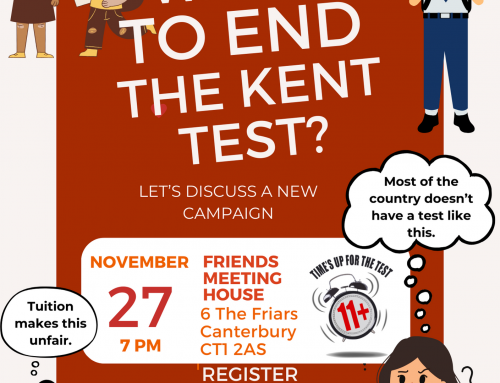SELECTION – THE MYTHS
Some answers to the points usually made by opponents of ending selection
1. Comprehensives have failed. Standards have fallen overall since grammar schools were abolished.
- More young people stay on at school and go to university now than when we had a selective system.
- OECD/PISA research shows highest achieving systems are comprehensive, A clear cut finding from PISA is that early differentiation of students by school is associated with wider than average socio-economic disparities and not with better results overall. (OECD Programme for International Student Assessment 2006)
- England does not have a fully comprehensive system. Selection into grammar schools in England still affects the intake of three quarters of secondary schools (Sutton Trust 2008)
2. Grammar schools offer poor children a route out of the ghetto. Where there is no selection by ability we have selection by postcode as people who can afford it move to be near the best schools. Better to test intelligence rather than money.
- There was no golden age when large numbers of poor children went to grammar schools and then on to university. In the past only about 10% of working class children went to grammar schools and 40% left with no qualifications. (Crowther report 1959)
- An education system based on escape routes for a few rather than excellence for all is not a system for the 21st century.
- The cheque book plays a major part now as parents pay to have their children coached or send them to prep schools to enable them to pass the 11plus.
- The proportion of children eligible for free school meals in grammar schools is dramatically less than in their locality. (DCSF School Composition 2008)
- Yes if selection is ended more children will be able to go to schools near their homes – surely this is to be welcomed?
3. Every other European country has selection and does better. When Germany reunited parents clamoured to change the East German comprehensive system to the West German selective system.
- Only Austria, Belgium, Germany, Luxembourg and the Netherlands have selective systems, some based in part on parental choice. Some others have selection/specialisation for post compulsory school ages.
- Finland does best in international comparisons and is comprehensive
- PISA the OECD programme comparing education systems found that Germany has a large gap between the achievement of the rich and the poor compared to comprehensive systems
- Research shows that countries with selective systems such as Germany, Hungary and Austria have very socially segregated school systems (Jenkins et al 2006).
4. Northern Ireland does better and it has selection. There more poor children go to university. Secondary moderns in NI do better than comprehensives in England.
- NI has a long tail of underachievement
- Scotland does better than Northern Ireland and has a fully comprehensive system for example there are more adults with qualifications in Scotland than NI.(DfES 2006)
- Comparisons of schools defined as secondary moderns or comprehensives are meaningless as some schools in fully selective areas are officially called comprehensives even though they will not have an all ability intake.
5. There were more state school pupils in Oxbridge/HE in the old days of grammar schools. Those who succeeded in the past have kicked away the ladder.
- Comparisons with the old days include direct grant schools as state schools. These were fee paying with some scholarship pupils. In the main these schools went private when most areas went comprehensive. In 1961 only 34% of all students at Oxford and 27% at Cambridge had attended a state secondary school. (Robbins 1961) Both take now around 50%
- Since comprehensive education was introduced far more young people have gone on to higher education. In the past very few young people with parents in manual jobs went to university. (Robbins 1961)
- Comprehensive pupils with the right grades are underrepresented at Oxbridge. Studies in the past have shown that comprehensive pupils were less likely to apply to Oxbridge and if they do, were less likely to be accepted. (Report for Oxford Vice Chancellors 1999) This is changing
6. There is nothing wrong with selection – children have to cope with failure.
- Children’s aptitudes, abilities or potential at 11 cannot be forecast reliably.
- Research has shown that 22% are wrongly attributed, ie some failed who would have passed and vice versa (Sutton Trust 2008).
- Selection separates children from an early age into different schools, dividing families and friends.
- Selection takes no account of the fact that children develop at different rates. It assumes that ability is fixed at 10+ and that children have therefore to have a different curriculum and schooling
- Selection is not a test of innate intelligence. Children who are coached are more likely to pass the test. (Ford 1969)
- ‘Passing’ the test is related to the number of grammar school places available.
7. We should not close these beacons of excellence.
- The campaign is not about closing schools but opening them up to all pupils.
- All schools now teach the National Curriculum and have pupil led funding. This will not change if grammar schools admit local children rather than selecting.
- Comprehensive schools can be beacons of excellence. There can be excellence without selection.
8. Selective Local Authorities do better, secondary moderns do better than comprehensives.
- Comparisons of local authorities have to be treated with caution. Comparisons fail to take cross borough movement of pupils into account. Selective local authorities tend to take in more able children at yr 7 and lose less able children. (DCSF School Composition 2008).
- Selective local authorities have lower levels of socio-economic disadvantage, for example in 2003 wholly selective authorities had 11% of pupils eligible for free school meals compared to 17% in wholly comprehensive areas. (PQ 20. 5.2006
- The schools official status may not reflect their intake. The Education and Training Statistics for the UK 2007 lists 3,343 schools as secondary schools of which 164 are grammars; 113 are modern; 248 are middle deemed secondary; 2 are technical; 23 are other and 2,793 are comprehensive.
9. We need choice.
- In a selective system only the children able to pass the test and their parents have more choice of schools. When all schools in an area are comprehensive, taking children of all abilities, all parents and children have more choice of schools. In any case the education system in England is diverse in character.
- A well managed, properly funded comprehensive school, supported by the local community, working with parents, using modern technology and collaborating with its neighbours can offer choice and diversity within the school for all its pupils.
10. Ending selection will cost too much and be chaotic.
- Changing admission criteria involves neither costs nor chaos.
- There will be savings for example in school transport and the administration of the tests and the ballot regulations. The costs of implementing ballot regulations until now is £2.32 million (Parliamentary Question 17 June 2009)
11. Bright children do better in grammar schools.
- Bright children do well in comprehensives too.
- Research shows that schools which have a reasonable academic balance of ability in their intakes do better.
- There are conflicting reports of the comparable outcomes, one estimated there was a difference of between zero and ¾ of a GCSE grade but that selective schools seem to select pupils already making faster progress at primary schools (Sutton Trust 2008)
12. There are only a few grammar schools – they don’t matter. Spreading a few bright children won’t make any difference.
- Selection affects not just those selected but those rejected too and other schools. Only a quarter of English secondary schools are not affected by selection into grammar schools (Sutton Trust 2008)
- 4.9% of English children are in grammar schools (Parliamentary Question 24.6.2009) so if we assume three times this number ‘failed’ the test then almost 15% of young people are affected by rejection at age 10 or 11.
13. Campaigners are confusing equality of outcome with equality of opportunity and they want mixed ability teaching everywhere.
- No one wanting to see an end to selection believes that schools should or do provide exactly the same for every child.
- The idea that comprehensive schools are monochrome is misleading, good comprehensives provide diversity and choice within the school.
- The campaign is to ending selection between schools. In fact most comprehensive schools do not teach mixed ability throughout the school. In any case studies throw doubt on the idea that setting gets better results than mixed ability teaching. The picture is more complex than that.
14. Parents want selection.
- Survey results depend very much on the question asked and if parents or the general public is polled. 57% of parents in Times Educational Supplement survey (2004) opposed selection.
- Some reports of surveys do not give the full picture. A survey for the Centre for Policy Studies in 2006 was reported as support for selection but in fact only 36% supported selection and 51% said children should be taught with others in mixed ability schools.
- A survey of adults of whom 33% were parents found that 84% thought that a broad ability intake in a school is essential or desirable (Ipsos Mori2009)
,




